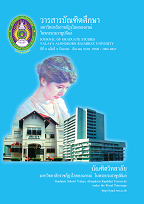การเปรียบเทียบผลสัมฤทธิ์การจัดกิจกรรมการเรียนรู้แบบร่วมมือรูปแบบ STAD เรื่องนาฏลีลา วิชาศิลปะ 2 USE OF LESSO PLANS BASEED ON STAD COOPERATIVE LEARNING MODEL TO PROMOTE ACHIEVEMENT OF MATHAYOMSUKA 4 STUDENTS ON TRADITIONAL THAI DANCE
Main Article Content
Abstract
บทคัดย่อ
การวิจัยครั้งนี้มีวัตถุประสงค์เพื่อ 1) พัฒนาแผนการจัดการเรียนรู้แบบร่วมมือรูปแบบ STAD เรื่องนาฏลีลา วิชาศิลปะ 2 2) เปรียบเทียบผลสัมฤทธิ์ทางการเรียนของนักเรียนชั้นมัธยมศึกษาปีที่ 4 ในการเรียนรู้เรื่องนาฏลีลา วิชาศิลปะ 2 ระหว่างกลุ่มทดลองกับกลุ่มควบคุม และ 3) ประเมินความพึงพอใจของนักเรียน ที่มีต่อการจัดการเรียนรู้แบบร่วมมือ รูปแบบ STAD เรื่องนาฏลีลาวิชาศิลปะ 2 การวิจัยนี้เป็นการวิจัยเชิงทดลองรูปแบบ Static Group Comparison Design เปรียบเทียบระหว่าง กลุ่มทดลอง และกลุ่มควบคุม กลุ่มตัวอย่างคือนักเรียนชั้นมัธยมศึกษาปีที่ 4 โรงเรียนนวมินทราชินูทิศ หอวัง นนทบุรี เครื่องมือที่ใช้ในการวิจัยคือ แผนการจัดการเรียนรู้แบบร่วมมือรูปแบบ STAD เรื่องนาฏลีลา แบบประเมินทักษะปฏิบัติ และ แบบประเมินความพึงพอใจ สถิติที่ใช้ในการวิเคราะห์ข้อมูลได้แก่ ค่าความถี่ ค่าเฉลี่ย ส่วนเบี่ยงเบนมาตรฐาน และสถิติเปรียบเทียบ คือ Independent Samples t-test
ผลการวิจัยพบว่า การประเมินทักษะปฏิบัติทางการเรียนของนักเรียนกลุ่มทดลองที่ใช้แผนการจัดการเรียนรู้แบบร่วมมือรูปแบบ STAD เรื่องนาฏลีลา และกลุ่มควบคุมแตกต่างกันอย่างมีนัยสำคัญทางสถิติระดับ .01 (t = 15.078, = 0.000) และความพึงพอใจของนักเรียนต่อการจัดการเรียนรู้แบบร่วมมือรูปแบบ STAD เรื่องนาฏลีลา อยู่ในระดับมาก (
= 4.17, S.D. = 0.11)
ABSTRACT
The purposes of this research were 1) to develop lesson plans designed based on the STAD. 2) Cooperative Learning Model to teach traditional Thai dance, and 3) to find out students’ attitudes towards the lessons. The subjects were Mathayomsuksa 4 students of Nawamintharachinuthid Horwang Nonthaburi. The research instruments were eight lesson plans using the STAD cooperative learning, a practical evaluation form and a questionnaire aimed to investigate the students’ satisfactions towards the lessons. Static Group Comparison Design was employed to collect data on students’ achievement. To collect the data the students were divided into two groups: the experimental where students were taught using learning management plans based on the STAD Cooperative Learning Model; and the controlled group where they were taught using a conventional approach.
The result showed that the achievement levels of students between experimental group and the control one were statistically significant different at level .01 (t = 15.078, = 0.000), and students were satisfied with the Thai dancing lessons based on STAD Cooperative Learning Model at the high level, (
= 4.17, S.D. = 0.11)
Article Details

This work is licensed under a Creative Commons Attribution-NonCommercial-NoDerivatives 4.0 International License.
บทความทุกเรื่องได้รับการตรวจความถูกต้องทางวิชาการโดยผู้ทรงคุณวุฒิ ทรรศนะและข้อคิดเห็นในบทความ Journal of Global of Perspectives in Humanities and Social Sciences (J-GPHSS) มิใช่เป็นทรรศนะและความคิดของผู้จัดทำจึงมิใช่ความรับผิดชอบของบัณฑิตวิทยาลัย มหาวิทยาลัยราชภัฏวไลยอลงกรณ์ ในพระบรมราชูปถัมภ์ กองบรรณาธิการไม่สงวนสิทธิ์การคัดลอก แต่ให้อ้างอิงแหล่งที่มา


